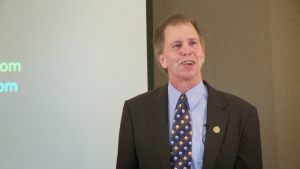 Welcome back!
Welcome back!
Last week, we focused on research and speech writing skills so you come across well and your audience listens.
This week, we’ll discuss presentation tools and techniques that will keep your audience on their seats’ edge.
To read suggestions 1 through 5, please click How to Speak Better in Public. Here we go!
#6
Your PowerPoint – Please Do NOT Read It to Me
The sister point to #3 in previous post on “Speaking Better in Public.” Just as reading a speech from your podium is a no-no, reading your PowerPoint to the audience is NEVER a good idea. It’s boring! I know how to read. And it’s a waste of the audience’s time. You’re better off emailing the PowerPoint to everyone and staying home.
#7
Make Your PowerPoint Visually Appealing
Too many people still make the mistake of putting a lot of bullet points on a single slide. Doing so makes the text too small to be read by your audience. Worse yet, it detracts from you while you’re speaking, because your audience will be straining to read the way-too-dense material on the screen.
There’s nothing wrong with including bullet points, just heed a few guidelines for better effect –
- Limit yourself to no more than 3 points on a single slide.
- Use a second color for the icon in front of each point. This lets the reader more easily distinguish one point from the next.
- Use more line space between bullet points than you do between lines within a bullet point. Again, this makes it easier to distinguish each individual nugget of knowledge.
- Group similar points on a given subject together. This helps the reader understand the context more readily.
- Consider providing the key points via a handout after the event. Either by email or physical paper. It provides follow-up communication as well as the chance to reinforce your key messages.
If you need to report a lot of numbers, results, and trends, there are so many creative ways you can design graphs to depict financial and performance charts, it boggles the mind. If you’re not good at this, or have no time, find somebody who is. Have them design the charts and then simply import them to your PowerPoint presentation.
And when you’re speaking more broadly (not needing numbers or lists), don’t be afraid to use illustrations from outside the industry. Seek out unexpected images to represent ideas or concepts or even feelings. It’s a great way to keep the audience’s attention. And if it helps, you can even embed very small images in the corner which can serve as memory triggers!
#8
Practice Out Loud & In-Motion
After you’ve created your PowerPoint and written your speaking notes (memory triggers), begin rehearsing by reading them to yourself, to get all the concepts in your head. You first need to build comfort with your topic and its key points.
But, once you’ve gotten the narrative in your head, start speaking your presentation aloud. Over and over. You will indeed stumble and need to review your notes a lot in the beginning. But as you repeat this exercise, you’ll get better. Really!
Think about it. The best presenters you’ve watched work, they never really use any speaking notes, do they? That’s your ultimate goal – to work without notes. But, no reason you have to be “that guy” right away.
As you practice, you’ll begin to understand where you need “memory triggers” to ensure you cover key points and do so in the right order. Here’s where you write them for use on stage.
There’s no substitute for practicing. A lot. Stand up, too. Move about the room. Make it as real a representation of how you’ll deliver your insights as you’re able.
And time yourself. You’d be surprised how quickly a minute goes by when you’re speaking. You can’t just go by “word count” in your software. When you speak, you have pauses. You draw out certain thoughts for effect. And you use emotion. These all extend the time needed to express yourself. So time yourself and adjust either your presentation or your speech style to ensure you fit in your allotted presentation time frame.
#9
Smile
I know. It sounds easy and obvious. But if you don’t speak a lot, it’s surprisingly difficult to do. We can find ourselves trying so hard to remember everything we want to say that our concentration shows on our faces. And that’s a bad look. (Been there, done that!)
On the flip side, we may be so preoccupied about embarrassing ourselves that our facial expression becomes one of worry. Again, not the look we’re going for. Without meaning to, we may come across as stern or humorless or tentative.
Learn to do a “facial check” every few minutes. In the mirror, practice different expressions. Feel what muscles are at work with each one. Morph each one into a smile. Take note how your face feels when you’re smiling. Observe how your eyes feel, where your brow is, the tension of your cheeks, the position of the corners of your lips, and more. Over time, you’ll be able to sense when you are, or aren’t, smiling, and you can adjust accordingly.
#10
The Podium is NOT a Flotation Device
That podium, whether it’s a big standing one or a small desktop one, is not your personal security blanket! Please do not hang onto it for dear life!
I know, it is SO tempting to put your notes on top of it, have the clicker for the projector at your side, and just start talking. DON’T. Unless there is literally no physical room for you to move around in.
Get out from behind the podium when you can. That block of wood is a barrier between you and your audience. It creates a “visual” fence that keeps you two from bonding. By actually walking around, you create an intimacy with your audience. You change the eye contact you can make and you become more of a person to them, someone they can relate to. And movement will actually make you feel more relaxed and in control. It seems counter-intuitive, but it’s true.
BONUS THOUGHT
Remember to Share the “Why”
People will pay better attention when they know why they should be listening. When you’re speaking, be sure that you continually include the “why.” Let the audience know the impact your ideas and information can have on their lives. What will they be able to do with this new knowledge? How can they use it to improve their own situations and solve challenges they face? Make sure the reasons why they should care are apparent.
REMEMBER, the audience really does want you to succeed! They aren’t there to judge you, they’re there to learn from you. Be open, be prepared, be authentic, and be helpful. That, and remember to practice, and you’ll be fine. You may even decide you like speaking in public. I know I did!
